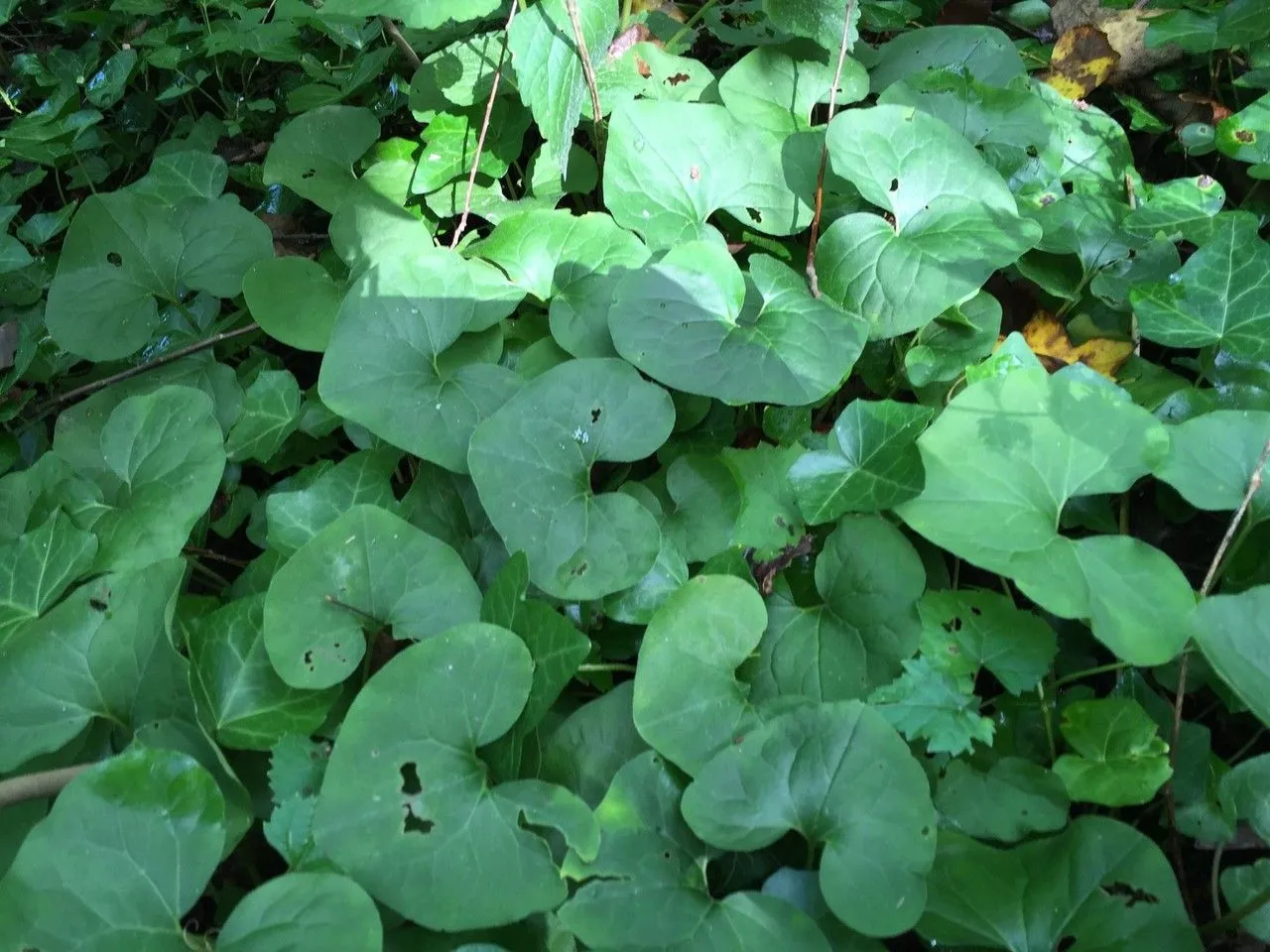
Author: L.
Bibliography: Sp. Pl.: 422 (1753)
Year: 1753
Status: accepted
Rank: species
Genus: Asarum
Vegetable: False
Observations: SC. & SE. Canada to NC. & E. U.S.A.
Canada snakeroot, scientifically known as Asarum canadense, is a remarkable plant indigenous to specific regions in North America. First documented in 1753, this perennial herb falls under the Aristolochiaceae family. It is primarily found in southeast Canada and the eastern United States, stretching from North Carolina to various regions of southeastern Canada.
Canada snakeroot thrives in shaded, wooded areas with moist, rich soils, often forming dense mats on the forest floor. The plant is notable for its heart-shaped, dark green leaves that grow in pairs, providing a lush ground cover in the understory of forests.
The flowering aspect of Canada snakeroot is modest yet intriguing. It produces unique, bell-shaped flowers that are a purplish-brown color, typically hidden beneath the foliage. These flowers contribute to its mysterious allure, often going unnoticed by casual observers due to their discreet positioning.
Apart from its aesthetic appeal, Asarum canadense has historical significance in traditional medicine. Indigenous peoples and early settlers valued it for its purported medicinal properties, primarily for treating ailments such as digestive issues and snake bites, which is reflected in its common name.
Ecologically, Canada snakeroot plays a vital role in its habitat by providing ground cover that helps prevent soil erosion. It also serves as a food source for various insects and small mammals, contributing to the biodiversity of forest ecosystems.
In summary, Canada snakeroot is a fascinating plant that offers both ecological benefits and historical significance. Its discreet beauty and role in traditional medicine make it a plant of considerable interest within its native range.
Eng: american wild ginger, canada snakeroot, canadian wild ginger, canadian wildginger, wild ginger, canada wild ginger
Fra: asaret du canada, gingembre sauvage, serpentaire du canada, asaret gingembre, snicroûte
Ita: asaro
Spa: asaro, serpentaria
Swe: kanadensisk hasselört
Deu: kanadische haselwurz, kanadische schlangenwurzel
En: Canada snakeroot, Wild ginger, American wild ginger, Canadian wildginger, Black Snakeroot, Black snakeweed, Broad-leaved asarabacca, Broadleaved asarabacca, Cat’s-foot, Colic Root, Colicroot, Colt’s-foot, Colt’s-foot snakeroot, Coltsfoot, Coltsfoot snakeroot, False colt’s-foot, Ginger root, Heart snakeroot, Short-lobed Wild Ginger, Southern snakeroot, Vermont snakeroot, Canadian Wild Ginger, Canada wild ginger
Az: Kanada çobandüdüyü
Zh: 加拿大细辛
Fi: Kanadantaponlehti
Fr: Gingembre sauvage, Serpentaire du Canada, Asaret du Canada, Asaret gingembre, Snicroûte
De: Kanadische Haselwurz, Kanadische Schlangenwurzel
It: Asaro
Pl: Kopytnik kanadyjski
Es: Serpentaria, Asaro
Sv: Kanadensisk hasselört
Zh-tw: 加拿大細辛
Taken Apr 25, 2021 by Mylaine Dionne (cc-by-sa)
Taken Apr 8, 2020 by Lee Armillei (cc-by-sa)
Taken May 3, 2019 by Soylu Mehmet (cc-by-sa)
Taken Nov 7, 2022 by Victoria Hill (cc-by-sa)
Taken May 4, 2021 by Ariane Lalande (cc-by-sa)
Taken Aug 9, 2015 by EOL − awright (cc-by-nc)
Taken Apr 5, 2015 by EOL − Matt Rung (cc-by-nc)
Taken Apr 22, 2015 by EOL − Kelly Fuerstenberg (cc-by-nc)
Taken Apr 16, 2015 by EOL − Jonathan Carpenter (cc-by-nc)
Taken Apr 15, 2015 by EOL − Dylan (cc-by-nc)
Taken May 20, 2020 by Chaitali Saqcena (cc-by-sa)
Taken Apr 23, 2006 by EOL − Steven J. Baskauf (cc-by-nc-sa)
Taken Apr 13, 2003 by EOL − Steven J. Baskauf (cc-by-nc-sa)
Taken Apr 13, 2003 by EOL − Steven J. Baskauf (cc-by-nc-sa)
Taken Apr 1, 2016 by EOL − caseyzill (cc-by-nc)
Taken Apr 24, 2020 by L. Ruiz (cc-by-sa)
Taken Apr 24, 2019 by Urban Kaytlin (cc-by-sa)
Taken Apr 29, 2020 by Chelsey Walter (cc-by-sa)
Taken Aug 5, 2017 by Margaret Cohan (cc-by-sa)
Taken May 22, 2020 by Jason Kilgore (cc-by-sa)
Taken Mar 19, 2020 by Danielle Smith (cc-by-sa)
© copyright of the Board of Trustees of the Royal Botanic Gardens, Kew.
© copyright of the Board of Trustees of the Royal Botanic Gardens, Kew.
Growth habit: Forb/herb
Family: Myrtaceae Author: (F.Muell.) K.D.Hill & L.A.S.Johnson Bibliography: Telopea 6: 402 (1995) Year: 1995 Status:…
Family: Rubiaceae Author: Pierre ex A.Froehner Bibliography: Notizbl. Bot. Gart. Berlin-Dahlem 1: 237 (1897) Year:…
Family: Sapindaceae Author: Koidz. Bibliography: J. Coll. Sci. Imp. Univ. Tokyo 32(1): 38 (1911) Year:…
Family: Asteraceae Author: A.Gray Bibliography: Pacif. Railr. Rep.: 107 (1857) Year: 1857 Status: accepted Rank:…
Family: Fabaceae Author: Medik. Bibliography: Vorles. Churpfälz. Phys.-Ökon. Ges. 2: 398 (1787) Year: 1787 Status:…
Family: Aspleniaceae Author: (Cav.) Alston Bibliography: Bull. Misc. Inform. Kew 1932: 309 (1932) Year: 1932…